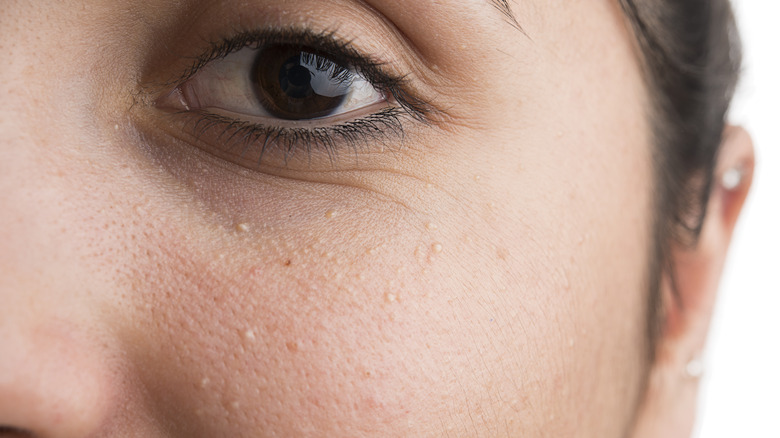Can Retinol Help Get Rid Of Skin Milia?
Struggling with hard, white bumps on your face that look like whiteheads but never seem to go away? Your skin is likely suffering from milia, also known as milium cysts, milk cysts, or oil seeds. These cysts form when dead skin cells fail to shed in order to clear the way for new ones to emerge, per The Skin Nerd. Instead, the new cells grow over the old ones, trapping them below the surface to mix with sebum and keratin, where they then harden, and eventually form into a cyst.
The good news about milia is that they're harmless to your health and don't usually present any troublesome symptoms. Most milia won't cause pain, itching, redness, or pose a risk of infection. Cosmetically, on the other hand, milia can cause annoyance at best and embarrassment or shame at worst. If you're interested in learning how to treat and prevent milia, there is hope. Here is your guide to battling these pesky cysts using at-home skincare products like retinol and other chemical exfoliants and knowing when to bring in a dermatologist.
Retinol for the treatment and prevention of milia
Retinol is a form of vitamin A that acts as a powerful chemical exfoliant for your skin. Not only does retinol remove dead skin cells, but it also increases the production of new cells, helps to clear debris from pores, and boosts the production of collagen, per Cleveland Clinic. Incorporating retinol into your regular skincare routine can help keep dead skin cells from becoming trapped inside your pores, which can lead to milium cysts.
As far as the milia cysts that are already hanging around under your skin, retinol can encourage the bumps to clear out on their own. The vast majority of milia will be gone within a few weeks. If your milia have been hanging on for more than a month or are especially bothersome to you, it may be worth a trip to your dermatologist for removal. The cysts are typically removed via a process known as deroofing, which involves carefully removing the new skin over the cyst and then extracting it.
Retinol alternatives
People who struggle with sensitive skin may not be able to tolerate retinol without significant irritation. If this is the case for you, there are other options for treating and preventing milia. The key to tackling this bumpy nemesis is exfoliation. Any chemical exfoliant will help to keep your pores clear and bump up the production of new skin cells. Luckily, there are several acids that fit the bill and tend to be gentler on the skin than retinol.
Look for products that are labeled as exfoliants or chemical peels. The gentlest acids currently on the market belong to a category called polyhydroxy acids or PHAs. As dermatologist Dr. Mara Weinstein Velez explained to Good Housekeeping, "The main difference is the size of the molecule. PHAs have a larger molecule and therefore don't penetrate as deeply as an AHA when applied to the skin. [That makes them] less irritating and better for sensitive skin." The most common PHAs to keep an eye out for are lactobionic, gluconolactone, and galactose acids. Along with adding a gentle chemical exfoliant to your skincare routine, be sure to replace any heavy moisturizers or creams with lightweight water-based or gel ones in order to minimize pore clogging and prevent milia formation.


